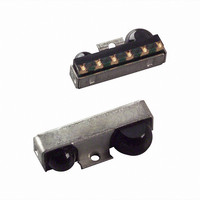HSDL-3000#007 Lite-On Electronics, HSDL-3000#007 Datasheet - Page 9

HSDL-3000#007
Manufacturer Part Number
HSDL-3000#007
Description
Infrared Transceivers IR Transceiver 115.2Kb/s
Manufacturer
Lite-On Electronics
Datasheet
1.HSDL-3000007.pdf
(14 pages)
Specifications of HSDL-3000#007
Wavelength
875 nm
Continual Data Transmission
115.2 Kbit/s
Transmission Distance
1.5 m
Radiant Intensity
75 mW/sr
Half Intensity Angle Degrees
30 deg to 60 deg
Pulse Width
7.5 us, 1.6 us
Maximum Rise Time
100 ns, 600 ns
Maximum Fall Time
100 ns, 600 ns
Led Supply Voltage
0 V to 7 V
Operating Voltage
2.7 V to 5.5 V
Maximum Operating Temperature
+ 70 C
Minimum Operating Temperature
- 20 C
Dimensions
9.1 mm x 3.65 mm x 2.7 mm
Data Rate
115.2kbs (SIR)
Idle Current, Typ @ 25° C
0.02µA
Link Range, Low Power
1.5m
Operating Temperature
-20°C ~ 70°C
Orientation
Side View
Shutdown
*
Size
9.1mm x 3.65mm x 2.7mm
Standards
IrPHY 1.3
Supply Voltage
2.7 V ~ 5.5 V
Lead Free Status / Rohs Status
Lead free / RoHS Compliant
Available stocks
Company
Part Number
Manufacturer
Quantity
Price
Recommended Reflow Profile
The reflow profile is a straight-line representation of a
nominal temperature profile for a convective reflow sol-
der process. The temperature profile is divided into four
process zones, each with different ∆T/∆time temperature
change rates or duration. The ∆T/∆time rates or duration
are detailed in the above table. The temperatures are
measured at the component to printed circuit board
connections.
In process zone P1, the PC board and HSDL-3000 pins are
heated to a temperature of 150°C to activate the flux in
the solder paste. The temperature ramp up rate, R1, is
limited to 3°C per second to allow for even heating of
both the PC board and HSDL-3000 pins.
Process zone P2 should be of sufficient time duration (100
to 180 seconds) to dry the solder paste. The temperature
is raised to a level just below the liquidus point of the
solder, usually 200°C (392°F).
Process zone P3 is the solder reflow zone. In zone P3, the
temperature is quickly raised above the liquidus point
of solder to 255°C (491°F) for optimum results. The
9
150
120
230
217
180
255
200
25
80
Process Zone
Heat Up
Solder Paste Dry
Solder Reflow
Cool Down
Time maintained above 217°C
Peak Temperature
Time within 5°C of actual Peak Temperature
Time 25°C to Peak Temperature
0
R1
HEAT
P1
UP
50
SOLDER PASTE DRY
R2
P3, R3P3, R4
100
Symbol
P1, R1
P2, R2
P4, R5
P2
150
150°C to 200°C
200°C to 255°C
255°C to 200°C
25°C to 150°C
200°C to 25°C
25°C to 260°C
> 217°C
> 255°C
260°C
dwell time above the liquidus point of solder should
be between 20 and 40 seconds. It usually takes about
20 seconds to assure proper coalescing of the solder
balls into liquid solder and the formation of good solder
connections. Beyond a dwell time of 40 seconds, the
intermetallic growth within the solder connections be-
comes excessive, resulting in the formation of weak and
unreliable connections. The temperature is then rapidly
reduced to a point below the solidus temperature of the
solder, usually 200°C (392°F), to allow the solder within
the connections to freeze solid.
Process zone P4 is the cool down after solder freeze. The
cool down rate, R5, from the liquidus point of the solder
to 25°C (77°F) should not exceed 6°C per second maxi-
mum. This limitation is necessary to allow the PC board
and HSDL-3000 pins to change dimensions evenly, put-
ting minimal stresses on the HSDL-3000.
It is recommended to perform reflow soldering no more
than twice.
T
R3
60 sec to 150 sec
Above 217°C
MAX 260°C
200
REFLOW
SOLDER
P3
Maximum ∆T/ time or Duration
R4
COOL DOWN
250
60s to 180s
60s to 150s
8mins max.
3°C/s-6°C/s
20s to 40s
P4
R5
-6°C/s
3°C/s
300
t-TIME
(SECONDS)





















